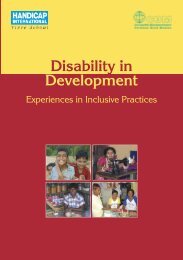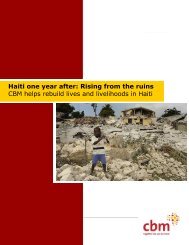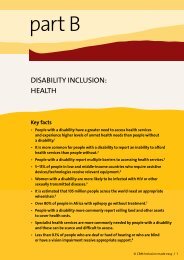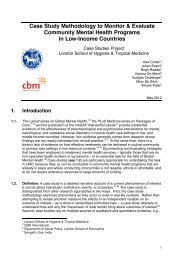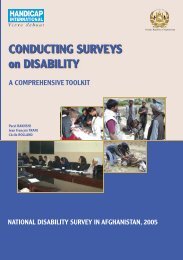Vision 2020 - World Health Organization
Vision 2020 - World Health Organization
Vision 2020 - World Health Organization
You also want an ePaper? Increase the reach of your titles
YUMPU automatically turns print PDFs into web optimized ePapers that Google loves.
ANNEX IV REVISED LIST OF VISION <strong>2020</strong> INDICATORS<br />
Minimal data collection<br />
The chores of record-keeping and reporting are often seen as a needless burden in many health-care settings, and much<br />
of the information collected and reported is never used. Only minimal data are to be collected for VISION <strong>2020</strong>, and collection<br />
should be undertaken only if the data are likely to be reliable and useful for decision-making. Wherever possible,<br />
existing mechanisms for data collection, with suitable modifi cation and strengthening, should be used.<br />
The critical data for the objectives of VISION <strong>2020</strong> are on:<br />
• the impact on the burden of blindness and visual impairment;<br />
• related human resource development;<br />
• related eye health sector and technology development; and<br />
• Member States’ commitment to implementation of VISION <strong>2020</strong> and development of partnerships.<br />
The framework details the main components of VISION <strong>2020</strong>, especially at country level. Reduction and eventual elimination<br />
of avoidable blindness will be achieved through interventions that are strengthened or initiated by national VISION<br />
<strong>2020</strong> partners, and these partnerships should be monitored. The actual interventions will vary with the pattern and<br />
epidemiology of blindness and visual impairment, and with the status of the health delivery system; however, interventions<br />
specifi c to blindness include the whole gamut of eye-health promotion, protection, treatment and at least some forms of<br />
rehabilitation. These interventions will require strengthening and therefore monitoring of human resources and relevant<br />
components of the health-care system, including health policy, health systems management and service delivery at all<br />
levels. Intersectoral collaboration, when called for, should also be monitored.<br />
National interventions require international support. Other critical areas for monitoring are the resources available at<br />
national and global levels, the technical support provided to countries and the effectiveness of research and development<br />
for new tools and strategies.<br />
1. Indicators for prevalence of visual<br />
impairment and disease control<br />
1.1 Indicators for prevalence of visual impairment<br />
Prevalence of visual impairment<br />
Level of collection<br />
Level of collation<br />
Brief definition<br />
Unit of measurement<br />
Purpose<br />
Links to other indicators<br />
Underlying definition<br />
Measurement method<br />
Limitations<br />
Frequency<br />
National (disaggregated in large countries)<br />
Regional or global<br />
Global, regional and national numbers of blind persons and numbers<br />
with low vision<br />
Absolute number<br />
Programme monitoring, public relations and advocacy<br />
Level of development, gender<br />
Presenting visual acuity < 3/60 and < 6/18–3/60 in the better eye<br />
Estimates from surveys or rapid assessments<br />
Requires population-based studies, some of which are of limited<br />
generalizability<br />
5 years<br />
71






